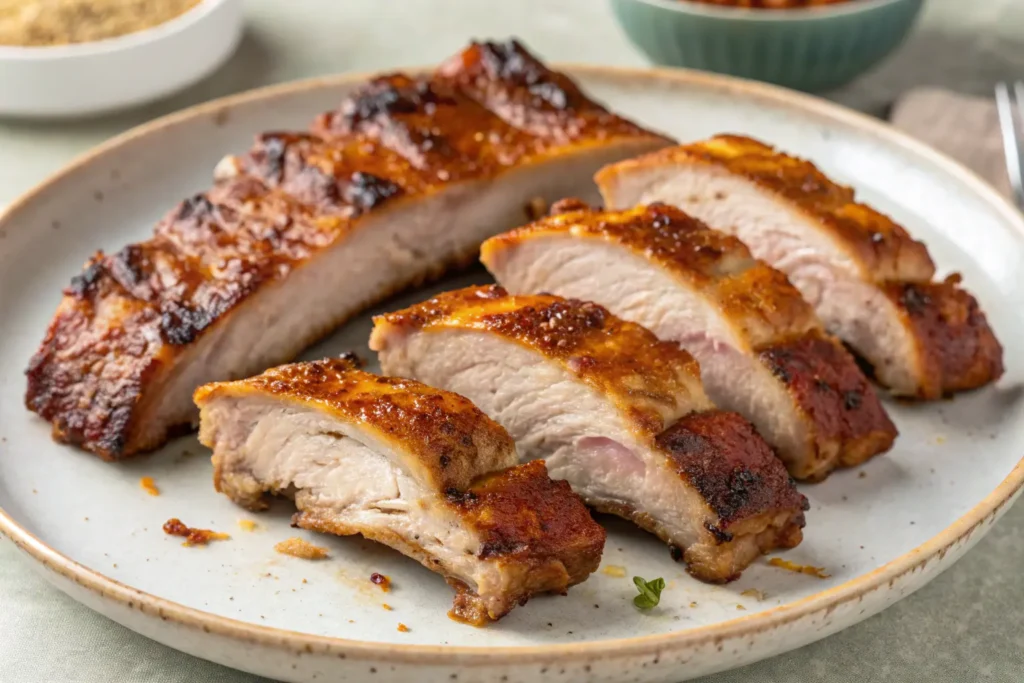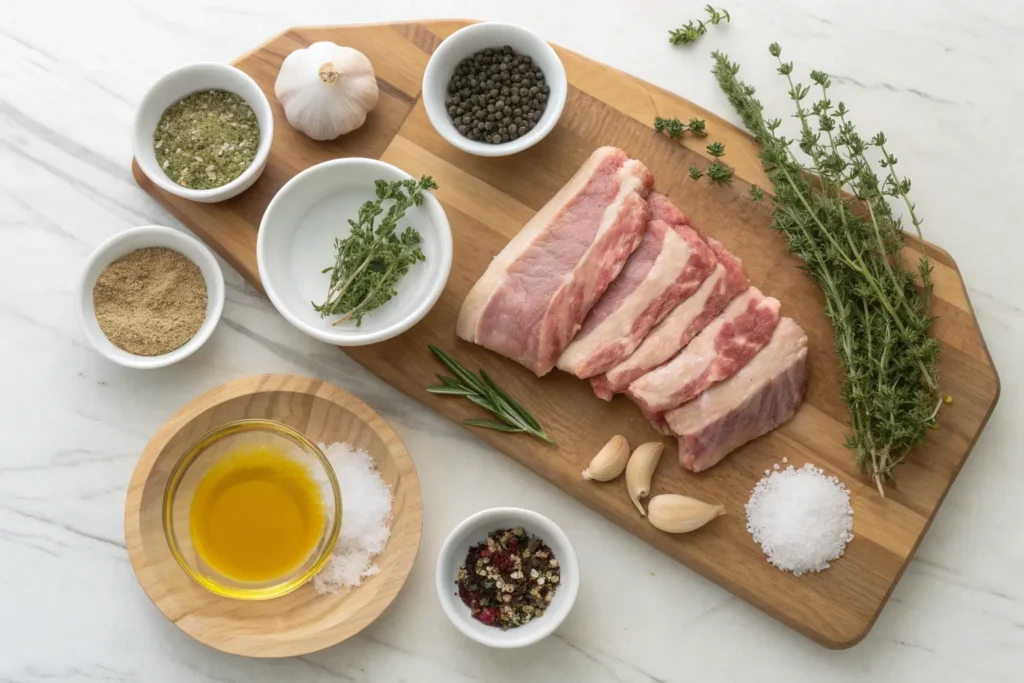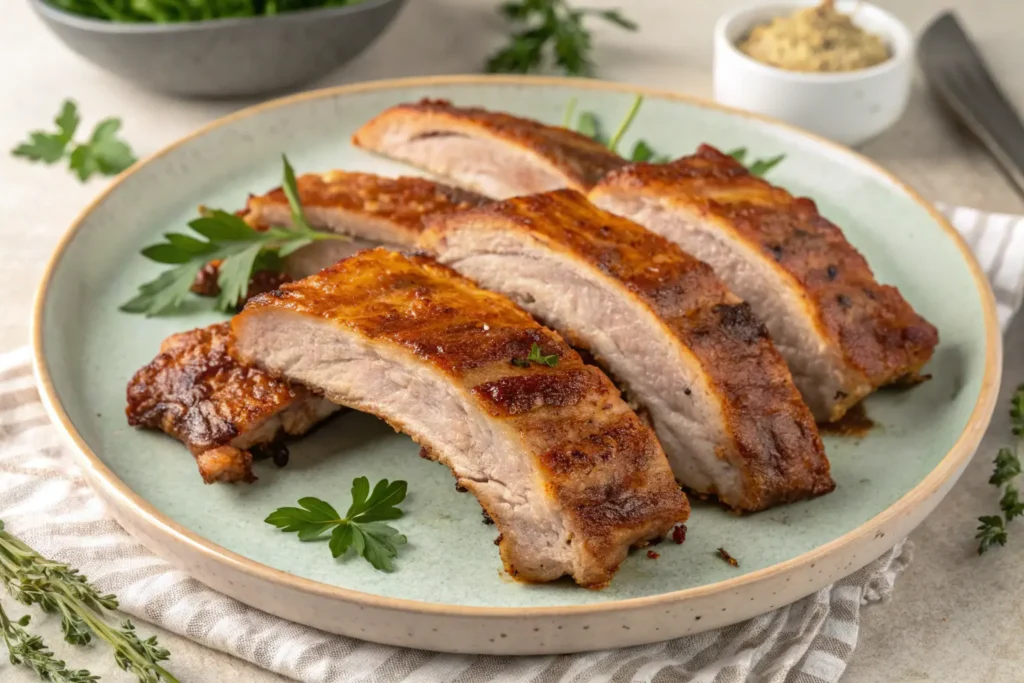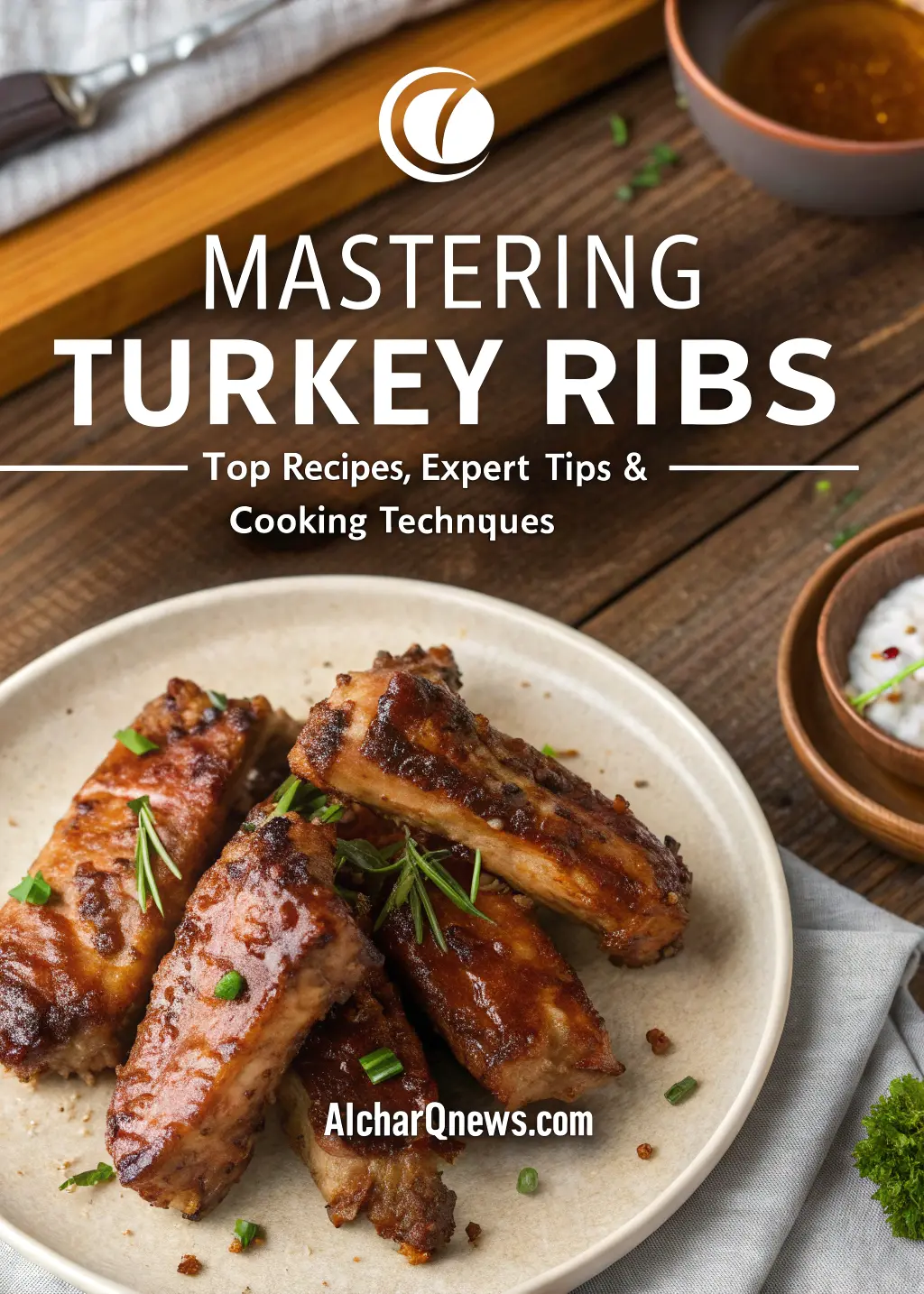Remember that moment when you first bit into something so unexpectedly delicious that it stopped you mid-conversation? That’s the magic of perfectly prepared turkey ribs. While often overlooked in favor of their pork and beef counterparts, turkey ribs represent one of culinary’s best-kept secrets – tender, flavorful, and remarkably versatile.
As a food enthusiast who stumbled upon turkey ribs at a neighborhood cookout years ago, I’ve devoted countless kitchen sessions to perfecting methods that showcase their unique character. Today, I’m sharing everything I’ve discovered about transforming this underappreciated cut into a mouthwatering centerpiece. Whether you’re watching your diet, seeking culinary adventures, or hoping to impress dinner guests with something extraordinary, these insights will forever change your approach to turkey preparation.
Table of contents

What Are Turkey Ribs? Understanding This Unique Cut
Anatomy of Turkey Ribs
Contrary to what many believe, turkey ribs aren’t traditional ribcage bones. They’re actually trimmed sections from the shoulder blade area, sometimes called “turkey breast ribs.” This distinctive cut features dark meat attached to strips of bone, offering a perfect balance of flavor and texture.
Unlike pork or beef ribs that come from the animal’s rib cage, turkey ribs represent a clever butcher’s approach to maximizing the bird’s potential. The cut mirrors the satisfying experience of eating traditional ribs while delivering turkey’s distinctive taste profile.
When shopping, look for pieces approximately 4-6 inches long with uniform meat coverage. Quality specimens display a rich, pinkish hue and feel firm to the touch without excessive moisture in the packaging.
Nutritional Benefits of Turkey Ribs
Choosing turkey ribs delivers impressive nutritional advantages over traditional alternatives. They typically contain about half the fat of pork ribs while delivering comparable protein content – approximately 28 grams per 4-ounce serving.
Moreover, turkey provides higher levels of B vitamins, particularly B6 and B12, which support nervous system function and energy production. According to dietary research published in the Journal of Nutrition Science, incorporating turkey into regular meal rotations correlates with better weight management outcomes compared to diets featuring primarily red meat.
For health-conscious diners seeking the satisfying experience of ribs without excessive caloric intake, turkey ribs represent an ideal compromise between indulgence and nutrition.
Essential Preparation Techniques for Turkey Ribs
Selecting Quality Turkey Ribs
Finding premium turkey ribs might require additional effort beyond typical grocery store visits. Your best resources include:
- Independent butcher shops with qualified meat specialists
- Poultry farms with direct-to-consumer sales
- Specialty food markets focusing on diverse meat options
- Online meat purveyors with overnight shipping capabilities
When evaluating options, prioritize freshness indicators like meat elasticity (it should spring back when pressed), minimal odor, and consistent coloration throughout the cut. While frozen options work adequately, fresh selections typically yield superior texture and flavor development.
Ask your butcher about the turkey’s origin, as free-range and organic options frequently provide enhanced flavor profiles due to varied diets and natural growth patterns.
Preparing Turkey Ribs Before Cooking
Proper pre-cooking preparation significantly influences your final results when mastering turkey ribs. Begin by thoroughly rinsing the ribs and patting them completely dry with paper towels. Next, carefully inspect for and remove any remaining feather fragments or excess fat pockets while maintaining the valuable thin fat layer that provides moisture during cooking.
For unparalleled tenderness, consider brining your turkey ribs for 4-6 hours before cooking. A basic brine combining 1 gallon of water with ½ cup kosher salt and ¼ cup granulated sugar creates the perfect foundation. Enhance this mixture with aromatics like crushed garlic cloves, peppercorns, and herb sprigs for additional flavor dimensions.
Alternatively, dry rubs applied 2-3 hours before cooking allow seasonings to penetrate the meat while drawing out surface moisture, creating perfect conditions for caramelization during cooking.

Mastering Turkey Ribs: Top 3 Cooking Methods
Smoking Turkey Ribs to Perfection
Smoking represents perhaps the most rewarding approach to mastering turkey ribs, developing complex flavor profiles while preserving the meat’s natural juiciness. For optimal results:
- Maintain a consistent smoking temperature between 225-250°F throughout the cooking process
- Select mild fruit woods like apple or cherry that complement rather than overpower turkey’s delicate flavor
- Monitor internal temperature, aiming for 165°F at the thickest section
- Consider the “3-2-1” method: three hours uncovered in smoke, two hours wrapped in foil with liquid, one hour unwrapped to develop bark
Periodic spritzing with apple juice or chicken stock prevents surface drying without washing away valuable smoke compounds that create the coveted pink smoke ring beneath the surface.
Oven-Baked Turkey Ribs for Indoor Excellence
When outdoor cooking isn’t feasible, oven preparation delivers remarkably comparable results. Position your oven rack in the middle position and preheat to 325°F for optimal heat circulation around your turkey ribs.
For superior moisture retention, create a foil packet by placing seasoned ribs on a generous sheet of heavy-duty aluminum foil, adding 2-3 tablespoons of liquid (stock, wine, or fruit juice), then sealing tightly. This effectively steams the ribs for the first cooking phase.
After 45 minutes, carefully open the packet, drain accumulated liquid, and continue cooking uncovered for an additional 15-20 minutes until the surface develops appealing caramelization. Apply your preferred glaze during the final 5 minutes, watching carefully to prevent burning.
Grilled Turkey Ribs for Summer Gatherings
Grilling introduces another dimension to turkey ribs through subtle smoke infusion and appealing char marks. Success depends on establishing distinct temperature zones on your grill:
- Create a high-heat zone (approximately 400°F) for initial searing
- Establish a medium-heat zone (approximately 325°F) for the primary cooking phase
- Designate a low-heat safety zone (approximately 225°F) for heat management
Begin by searing both sides over high heat for approximately 2 minutes per side to establish caramelization, then transfer to the medium zone to complete cooking. Turning the ribs every 7-8 minutes ensures even cooking while preventing excessive charring.
For gas grills, consider adding wood chips in foil packets with ventilation holes to introduce subtle smoke character. For charcoal grills, add pre-soaked wood chunks directly to the coal bed before cooking.
Top Turkey Rib Recipes Worth Mastering
Classic Smoky BBQ Turkey Ribs
Ingredients
| Ingredient | Quantity | Notes |
|---|---|---|
| Turkey ribs | 2-3 pounds | Request separation from butcher |
| Brown sugar | ¼ cup | Dark variety provides deeper molasses notes |
| Paprika | 2 tablespoons | Smoked variety strongly recommended |
| Garlic powder | 1 tablespoon | Provides even distribution versus fresh garlic |
| Black pepper | 1 tablespoon | Coarsely ground for texture contrast |
| Kosher salt | 2 teaspoons | Crystal size improves adherence |
| Cayenne pepper | ½ teaspoon | Adjust according to heat preference |
| Apple juice | 1 cup | For periodic spritzing during cooking |
| BBQ sauce | ½ cup | Preferably one with balanced sweetness |
Begin by thoroughly combining all dry ingredients in a small bowl, breaking up any brown sugar clumps. Apply the mixture generously to all surfaces of your turkey ribs, pressing gently to ensure adherence. Allow the seasoned ribs to rest at room temperature for 30-45 minutes, enabling the rub to attract surface moisture.
When using a smoker, maintain 235°F throughout the cooking process, adding wood chunks during the initial two hours only. After three hours, verify the internal temperature has reached approximately 145°F, then wrap the ribs tightly in butcher paper or foil along with 2-3 tablespoons of apple juice.
Return to the smoker for another hour, then unwrap and apply your BBQ sauce in two thin layers, allowing 15 minutes between applications. Once the internal temperature reaches 165°F, remove from heat and allow 10-15 minutes of resting time before serving.
Asian-Inspired Sticky Glazed Turkey Ribs
Ingredients
| Ingredient | Quantity | Notes |
|---|---|---|
| Turkey ribs | 2-3 pounds | Separated for consistent cooking |
| Soy sauce | ¼ cup | Reduced sodium provides better flavor control |
| Honey | 3 tablespoons | Local varieties offer distinctive character |
| Rice vinegar | 2 tablespoons | Creates balanced acidity |
| Ginger | 1 tablespoon | Fresh, microplaned for maximum flavor |
| Garlic | 3 cloves | Minced finely for even distribution |
| Sesame oil | 1 teaspoon | Use sparingly as flavor intensifies with heat |
| Red pepper flakes | ½ teaspoon | Customize according to preference |
| Green onions | 3 stalks | Bias-cut for presentation |
| Sesame seeds | 1 tablespoon | Lightly toasted for enhanced aroma |
Combine all liquid ingredients with ginger, garlic, and pepper flakes in a medium bowl. Reserve 1/3 cup of the mixture separately in the refrigerator for later glazing. Place turkey ribs in a shallow dish and pour the remaining marinade over them, turning to coat all surfaces. Cover and refrigerate for 3-6 hours, turning occasionally.
Preheat your oven to 325°F. Remove ribs from marinade (discard used marinade) and arrange on a wire rack positioned over a foil-lined baking sheet. Roast for approximately 35 minutes, then brush with the reserved marinade. Continue roasting for 15-20 additional minutes, applying marinade every 5 minutes to build a glossy, flavorful glaze.
The ribs should reach an internal temperature of 165°F when fully cooked. Before serving, sprinkle with toasted sesame seeds and freshly sliced green onions for visual appeal and flavor enhancement.
Expert Tips for Mastering Turkey Ribs
Common Mistakes to Avoid
Even experienced cooks sometimes encounter challenges when preparing turkey ribs for the first time. Steering clear of these common pitfalls ensures consistently excellent results:
- Overcooking: Turkey’s lower fat content makes it more susceptible to drying than pork or beef. Always prioritize internal temperature readings over time-based guidelines.
- Inadequate Seasoning: Turkey’s milder flavor benefits from more assertive seasoning than you might use with other meats. Season generously, but taste your preparations before applying.
- Improper Cutting: Always slice turkey ribs perpendicular to the bone direction, otherwise, you’ll create stringy, tough portions that detract from the eating experience.
- Neglecting Resting Time: Allowing 10-15 minutes of resting after cooking permits juices to redistribute throughout the meat, significantly improving moisture perception.
Flavor Enhancing Techniques
Elevate your turkey rib preparation through these advanced approaches:
- Smoke Ring Development: For enhanced visual appeal and flavor penetration, spritz your ribs with apple juice containing a teaspoon of dissolved pink curing salt (Prague Powder #1) before smoking.
- Progressive Glazing: Rather than applying sauce once, build layers by brushing with thin applications every 5-7 minutes during the final cooking phase.
- Compound Butter Finish: For extraordinary richness, place a pat of herb-infused butter on each rib portion immediately before serving, allowing it to melt into the meat’s surface.

Frequently Asked Questions About Mastering Turkey Ribs
Common Questions on Turkey Rib Preparation
How do I know when my turkey ribs are done cooking? When mastering turkey ribs, rely on temperature rather than visual cues. They’re properly cooked when reaching an internal temperature of 165°F measured with an instant-read thermometer inserted into the thickest portion without touching bone. You’ll notice slight meat retraction from bone ends and clear-running juices.
Can I prepare turkey ribs in advance for gatherings? Absolutely! For best results when entertaining, cook your turkey ribs to approximately 155°F internal temperature, then cool quickly and refrigerate. About 30 minutes before serving, place them in a 300°F oven with 1/4 cup liquid in the bottom of the pan, covered with foil. Heat until they reach 165°F internally for perfect temperature and texture.
Where can I find turkey ribs since they’re not common in grocery stores? Sourcing quality turkey ribs requires some legwork. Your best options include independent butcher shops with full-service meat counters, specialty poultry retailers, or direct orders from your supermarket meat department with advance notice. Several online meat purveyors now offer this specialty cut with overnight shipping for maximum freshness.
Can I substitute turkey ribs in recipes that call for pork ribs? You can successfully adapt most pork rib recipes for turkey ribs by making key adjustments. Reduce overall cooking time by approximately 25%, increase moisture elements (liquids, spritzing frequency), and consider slightly more assertive seasonings to complement turkey’s milder flavor profile.
How long can I store turkey ribs in the freezer? For optimal quality, store raw turkey ribs in the freezer for up to 9 months when properly vacuum-sealed or tightly wrapped with plastic wrap followed by aluminum foil to prevent freezer burn. Cooked turkey ribs maintain good quality for approximately 3 months when properly stored in airtight containers.
Your Path to Mastering Turkey Ribs
Becoming proficient with turkey ribs transcends merely following recipes—it requires developing intuition for how this unique cut responds to various techniques and flavor profiles. As you experiment with the methods shared here, you’ll establish personal preferences and likely create signature variations reflecting your culinary style.
The journey toward perfecting turkey ribs offers rewards beyond delicious meals. You’ll develop transferable skills applicable to numerous cooking scenarios while expanding your repertoire with a healthier, yet equally satisfying alternative to traditional rib preparations.
Whether you’re seeking impressive holiday alternatives, healthier options without flavor compromise, or simply expanding your cooking capabilities, turkey ribs provide endless possibilities for culinary creativity and satisfaction.
Which approach to mastering turkey ribs interests you most? Will you begin with the classic smoky BBQ variation or venture into international flavors? Share your experiences or questions in the comments below—I’m eager to hear how your turkey rib adventures unfold!
Have you given our recipe a try?
There are no reviews yet. Be the first one to write one.

